For a long time we have been repeating on these pages that the mere visitor count should not be the yardstick by which to measure the success of an exhibition. Similarly, we have always refrained from evaluating the success of an exhibition on the basis of the ratio of visitors to investment, and this for a simple reason: the echo of an exhibition, when it is supported by a serious project, when it is appropriate and when it is scientifically impeccable, can resound vividly and loudly well beyond the day of the finissage. Because a good exhibition produces a result, in terms of broadening and advancing knowledge and building the basis for future projects, that is almost always destined to last. However, when one has the good fortune to evaluate events such as Canova. Il viaggio a Carrara (Carrara, CARMI Museum, from August 1, 2019 to June 10, 2020), one is doubly bewildered, since one must first understand whether one is faced with an opportunity for cultural deepening or an entertainment product, and then one must draw all the appropriate evaluations, once one has established in which category to place the unusual event, which, in this case, actually falls somewhere between the exhibition (of which it preserves some of the basic conditions: the presence of works of art, a route divided by rooms, explanatory apparatuses, and a catalog) and the multimedia show à la page, of those so much in vogue in recent times, and which involve the extensive use of projections, emotional films and soundtracks signed by renowned musicians, and the use of a narrated voice that is familiar to most (in our case, that of Adriano Giannini, chosen to accompany the audience in the story between the rooms).
Wanting to categorize Canova. The Journey to Carrara in the roster of exhibitions, it might be difficult to level criticism at the organization for the mere fact that, in six months, the exhibition has garnered the meager figure of five thousand four hundred visitors, between paying and free. Meanwhile, to the event’s detriment played the fact that the Carrara exhibition was squeezed between at least three major exhibition opportunities dedicated to Antonio Canova, and moreover, all of them original: the one at the Museo Archeologico Nazionale in Naples, which aimed to explore the relationship between Canova and antiquity; the one at the Museo di Roma in Palazzo Braschi, which instead investigated Canova’s relationship with Rome; and the exhibition at the Gallerie d’Italia in Piazza Scala, which offered an unprecedented comparison between the genius from Possagno and his rival Bertel Thorvaldsen. An exhibition like the one in Carrara, which, unlike the others just mentioned, proposed nothing new, neither from a scientific point of view (except, of course, for the discovery of a document attesting to a supply of marbles to Canova: it is certainly important for studies, but I suspect that it does not exactly represent the kind of discoveries capable of gathering throngs of eager visitors outside the museum entrances), nor as far as the proposal to the public is concerned, since one loses count of the number of exhibitions that, in Carrara alone, have been devoted in recent times to Canova’s plaster casts (and this is because for years the gipsoteca of the Academy of Fine Arts has been waiting to find a permanent home, which perhaps, at last, is on the horizon: but this is a digression beyond the scope of CARMI’s review). Natural, then, that the expected visitors from all corners of the country, wanting to approach Canova’s art, chose events of higher stature: and whether for Carrara it was the adversity of fate (in my memory, I cannot recall a period that saw the almost simultaneous presence of three large and important exhibitions on Canova, especially since no anniversary was being celebrated) or poor planning (since events such as those in Rome, Milan and Naples are known well in advance), will be the subject of passionate debate in the city. The result of the exhibition in Carrara, therefore, would have been meager even if it had been a new and interesting exhibition, given that, in terms of budget and available means, CARMI cannot compete with the three aforementioned subjects, and whoever planned the exhibition (if it was bad planning and not bad luck) should have known this.
A flop, then, which on closer inspection could be motivated by contingent reasons: the problem, however, also lies (and perhaps to a large extent) in the exhibition itself. To begin with, Canova. The trip to Carrara saw the exhibition of a small nucleus of Canova plaster casts from the local Academy of Fine Arts (five in total), moved a few hundred meters for the occasion and decked out with the same clutter of multimedia paraphernalia seen the year before for Magister Canova in Venice, produced by the same company that organized the Apuan show. Only, in Carrara everything was reduced to a small size, to adapt the event to the spaces of Villa Fabbricotti, drastically tiny compared to those of the Scuola Grande della Misericordia, where Magister Canova was held: and everyone will agree that a multimedia show owes a significant portion of its eventual success also to the container that hosts it. It is one thing, then, to project videos in the immense hall of the Venetian confraternity (with good grace for the 16th-century frescoes there, but after all, it is well known that multimedia certainly does not stop in front of the artists of past centuries), in ancient times intended for the gatherings of the members of the School, and moreover the second largest in Venice after that of the Doge’s Palace, and another thing is to imagine, touching the sense of the ridiculous, a similar path in the rooms on the ground floor of a nineteenth-century residence: one did not need experts in modern technology to understand that the result would not be quite the same.
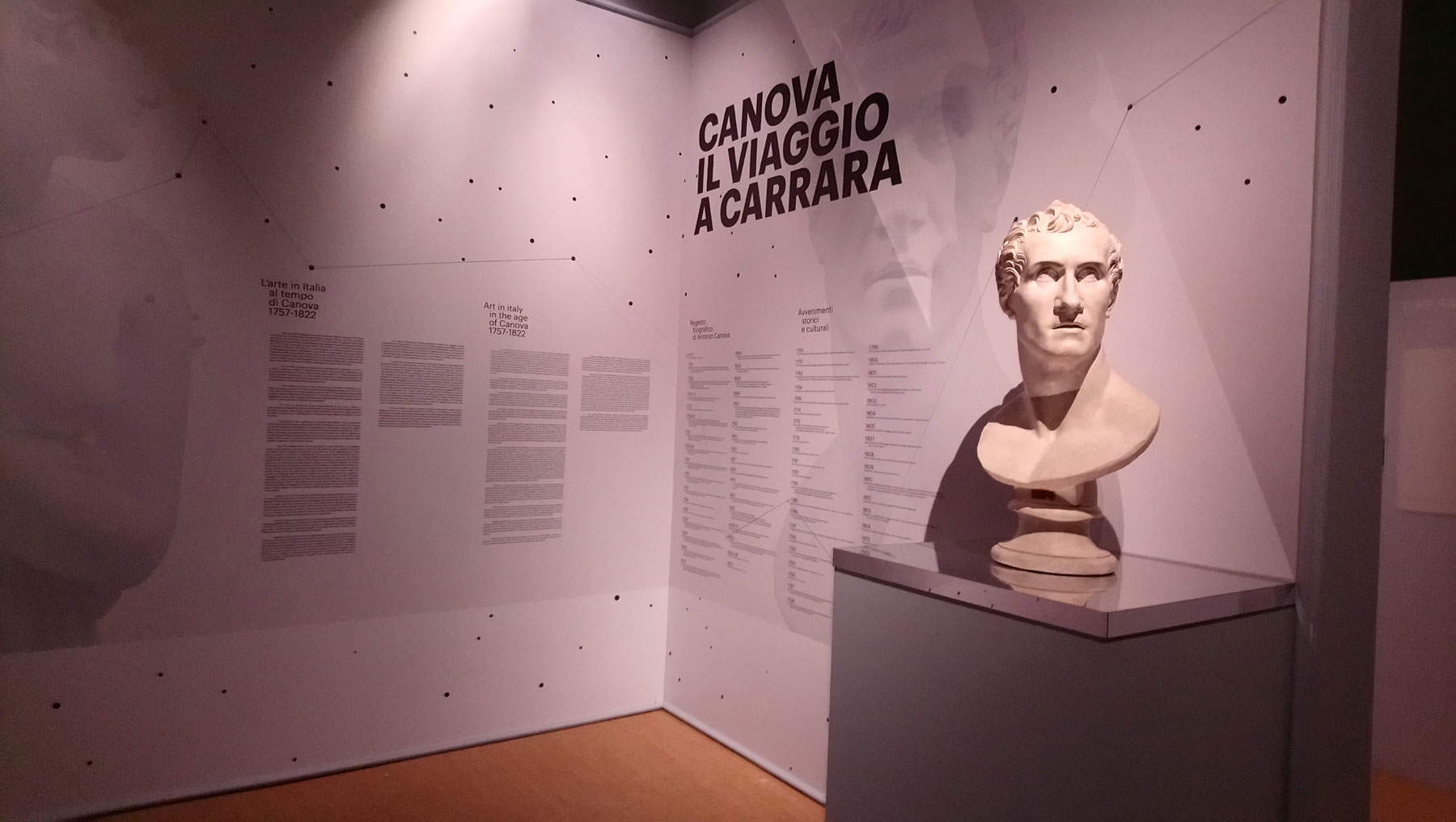 |
| Beginning of exhibition with plaster cast of Canova’s self-portrait. |
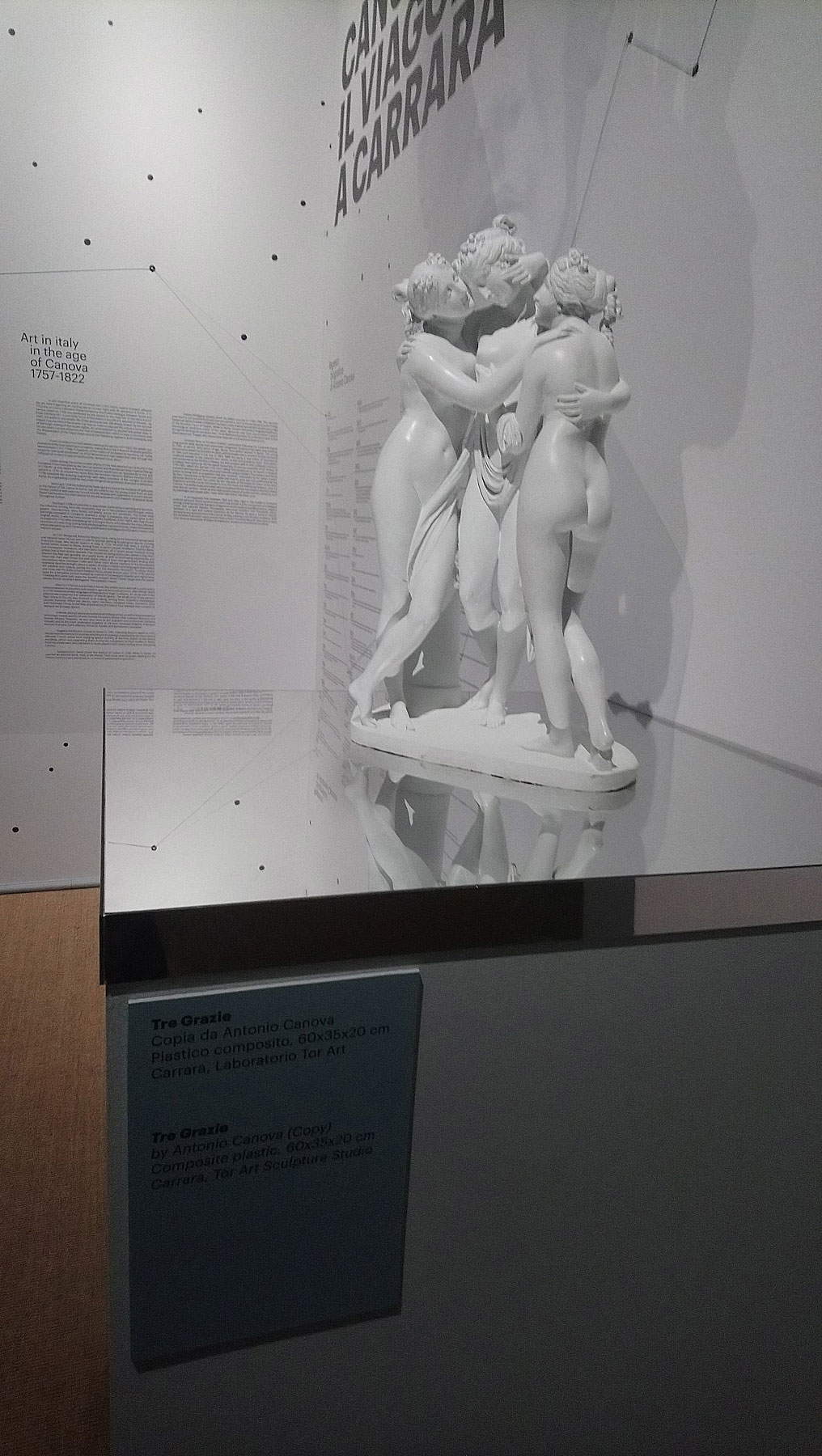 |
| ... later replaced, from the beginning of February, with a small-scale reproduction in composite material of the Three Graces |
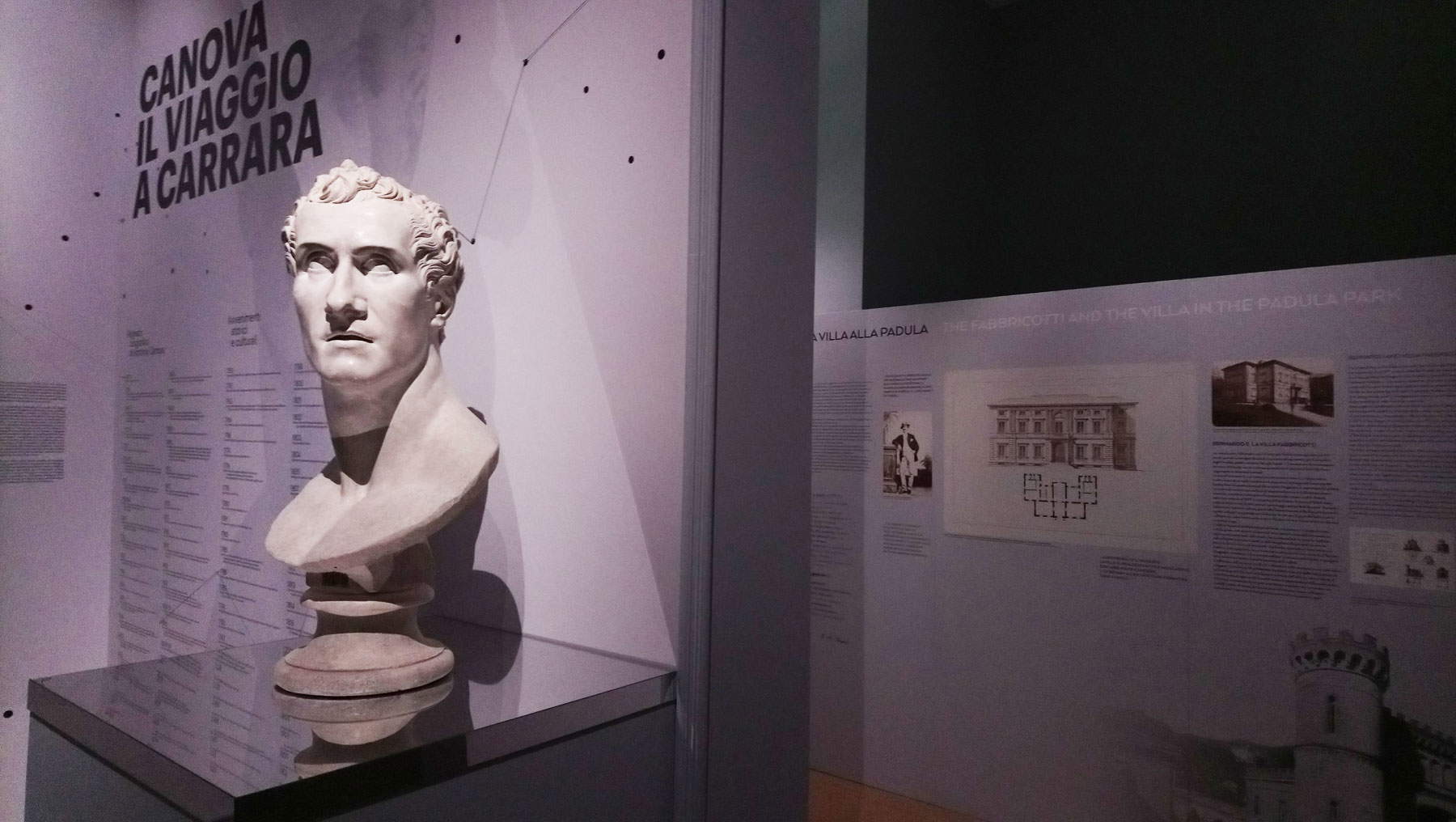 |
| The panels, right, with the history of Villa Fabbricotti blending into the exhibition itinerary |
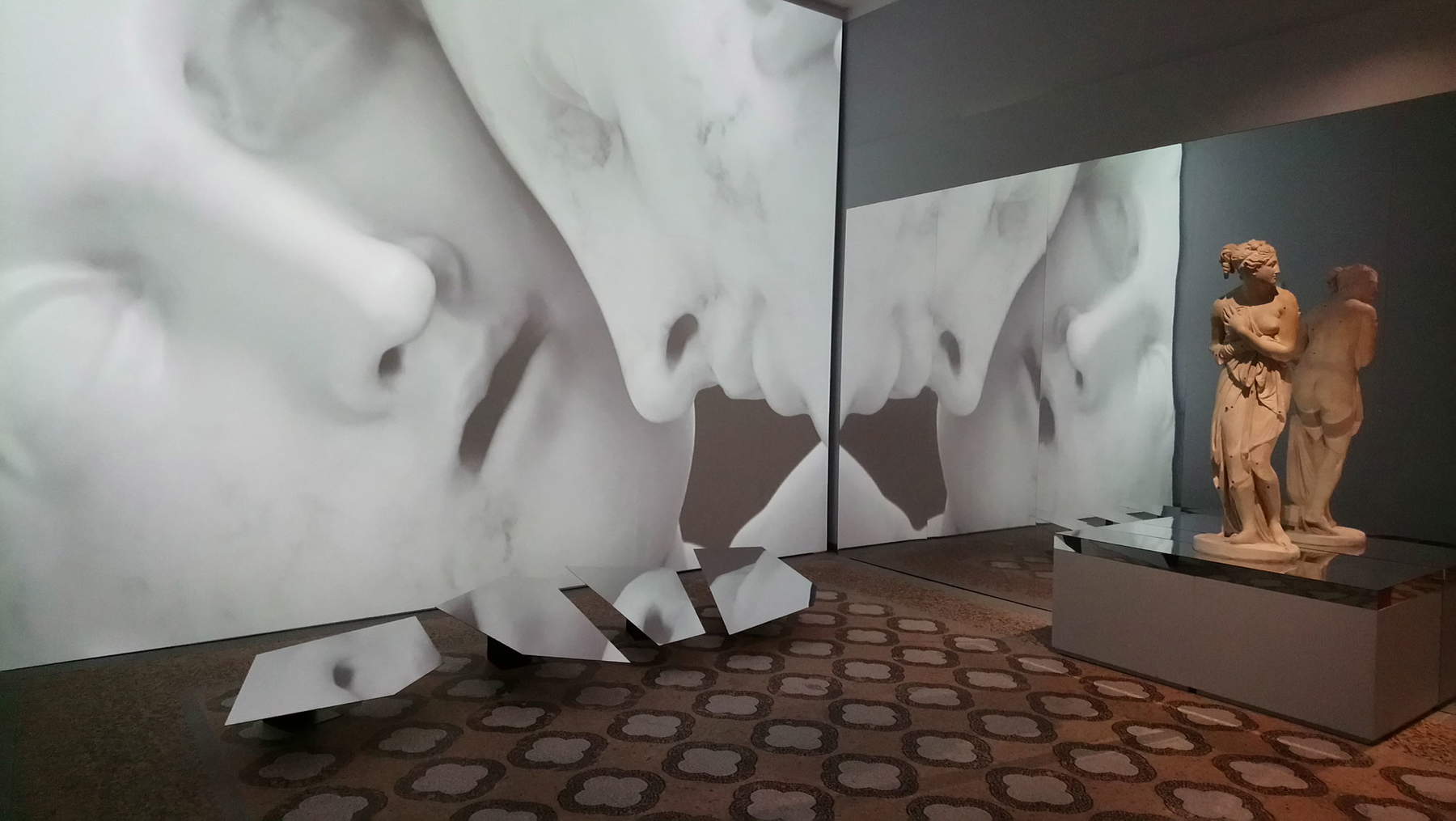 |
| The Venus Italica Hall before... |
| <img src=’https://cdn.finestresullarte.info/rivista/immagini/2020/1243/sala-venere-italica-vuota.JPG ’ alt=“... and after, with the plaster gone ” title=“=”... and after, with the plaster gone “ /></td></tr><tr><td>=”... and after, with the plaster gone |
It will be objected, however, that the Carrara event does not intend to re-propose the one in Venice, but aims to offer a different experience to its audience: to unite works and video, in short, to make two different languages “dialogue.” How aphasic this “dialogue” is, however, will be clear to anyone who cares to visit the exhibition: what will silent videos reproducing its details have to add to a work that the visitor can see live? One might answer with what proponents of such exhibitions usually and parrotily assert: video allows one to catch details that otherwise, to the naked eye, might escape. And since when, pray tell, has the custom of appreciating the work of art by the entomologist’s method become widespread? How does the aesthetic experience in the presence of the work come out enriched by the sight of a little finger, eye or nipple reproduced at tens or hundreds of times their actual size? Are we really sure that, in order to achieve that “national appeal” vague in institutional texts, it is sufficient to place, behind the plaster casts, screens on which fade grainy blow-ups of those same works that the public has the opportunity to admire in their manifest concrete evidence? Are we really convinced that this is the “unseen” that Canova’s art needs to reach the public?
Let us admit, however, that the answer to all these questions is resoundingly affirmative: it is also a matter of assessing whether the path holds up to the purposes. And Canova ’s. Journey to Carrara is not an exhibition itinerary: it is a terrifying ramshackle hodgepodge that makes a mockery of its visitors’ intelligence and that, moreover, evidently changes over time as well, because from August to the present some elements in the layout have changed, and additional objects have been announced for the coming weeks. The seriousness of an exhibition is also judged on the basis of the fact that, at least in theory, theprocess should not be altered in haste, unless there are completely exceptional circumstances: here, however, the exhibition in its entirety has been disrupted, since the plaster casts returned to the Academy on January 31. And the exhibition, therefore, will find itself unencumbered by its main pieces for four and a half months: basically, for half its duration. What is the point of all this? But how much amateurism will it take to set up an exhibition that suddenly loses the main reason why it is worth visiting? Wouldn’t it have been better to provide for a shorter exhibition (not even the most important events last ten months!) and reserve another proposal for the public?
Wanting, however, to pretend that the plaster casts are all still in place, it is still necessary to come to terms, as mentioned, with the route. Meanwhile, it must be pointed out that the colors of the displays do not differ from those of the permanent rooms, and the risk is that the visitor who crosses the threshold of the CARMI Museum for the first time will wonder what Canova’s biography has to do with the history of Villa Fabbricotti, since the panels are adjacent, are in every way similar, and are therefore easily confused. In the second room, one becomes familiar with the format of the event: the plaster cast of Venus italica (it should be specified that the exhibition’s itinerary does not follow a chronological order) stands out, alone, inside a bare room, with a wall on which flow reproductions of details of the sculpture and other Canova works (indeed: it stood out, because it has now disappeared, just like the cast of Canova’s self-portrait in the first room, replaced by a small-scale, composite reproduction, made by a Carrara workshop, of the Three Graces, and like all the other plaster casts in the Academy). In one corner, the public can look at models of the Three Graces (on a very small scale, toy size: if the intent was to make the public perceive details that are otherwise missed, it is completely missed here) and, most importantly, they can browse through the facsimile of Canova’s album of drawings kept in Bassano del Grappa... with a pair of gloves on! But if it is a reproduction, can anyone know what on earth the gloves will be used for? Was there a fear of deterioration of the photocopies? Was it intended to let visitors experience the touching thrill of wearing a pair of protective gloves?
Electrified by the thrill tested and being careful not to bump into the sharp mirrors scattered along the floor (evidently the organization cultivates a deep disdain for the dense throngs who, in warm weather, roam museums in short pants: perhaps she has a point, but that does not mean we should set traps for the shins of others), we catapult into the third room, where a huge oval catafalque awaits us with a handful of viewers installed that allow us to savor (not everyone, however: those placed higher up are precluded to those who are less than five feet tall) some blurred images of Canova’s Paolina Borghese. Says the catalog that this “exciting installation” (and, incidentally, let alone if the accompanying lexicon could do without the adjective “exciting”) offers "an opportunity to explore in detail the Paolina Borghese work, reproduced thanks to a skillful play of stereoscopic images made especially for the installation exclusively at the Galleria Borghese in Rome.“ Here, the insult to the visitor touches Himalayan heights: how it is possible to ”explore in detail" a sculpture through a peep show of the lowest order and which by now represents a démodé device even for the most hardened onanist, still remains a mystery (and the fact that it was designed for the Galleria Borghese constitutes an aggravating factor, in the opinion of the writer). But couldn’t the scopophilia have been left to the Lino Banfi movies, the ones where the horny protagonists peek through locks, to place a reproduction of the Pauline in the room instead?
 |
| The mini-models intended to tell the story of Canova’s creative process. |
 |
| The facsimile of Canova’s album to leaf through... with protective gloves |
 |
| Pointed mirrors on the floor in the Venus Italica room |
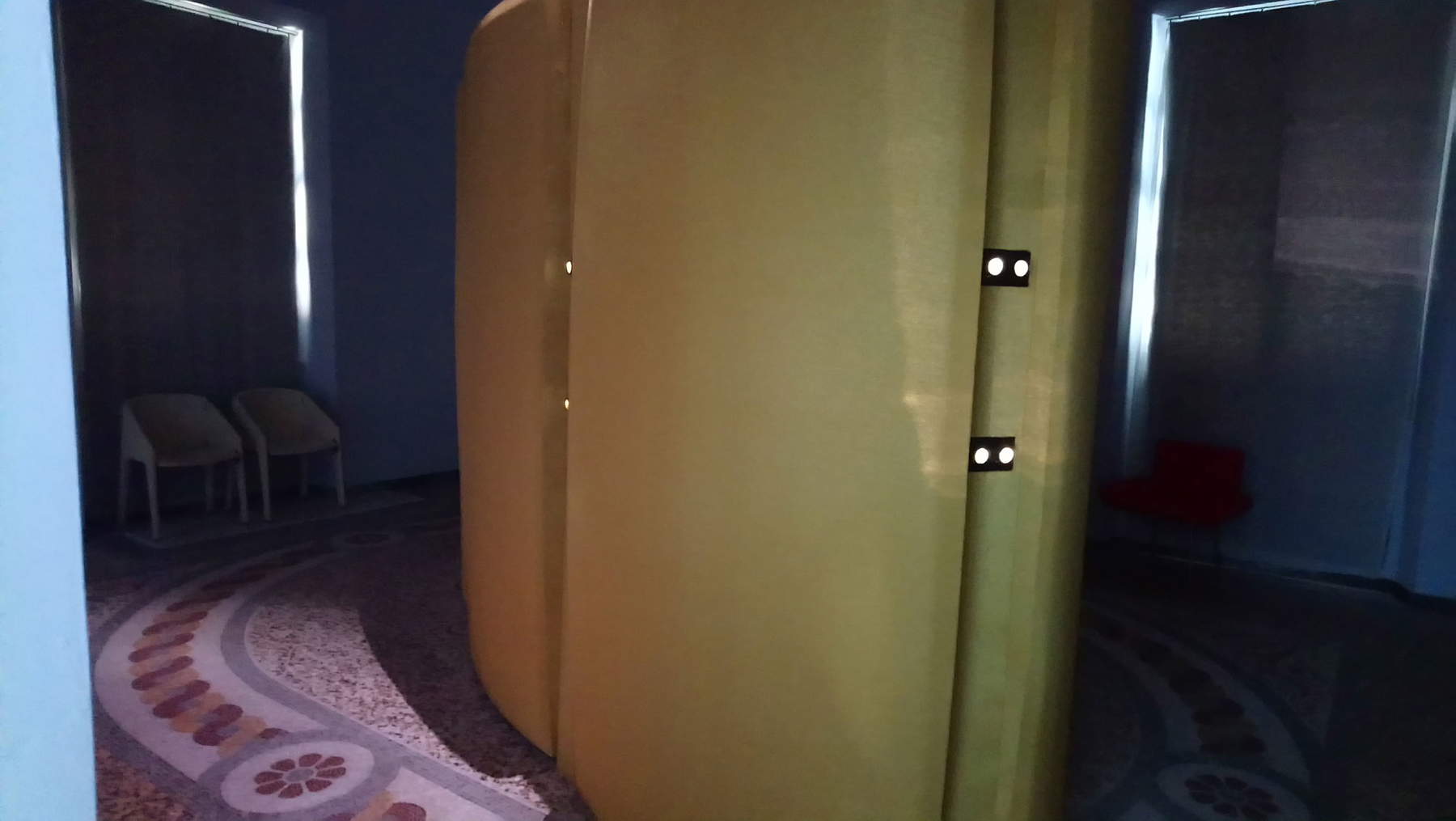 |
| The installation with viewers to see the Paolina Borghese |
 |
| Here’s how the Paolina Borghese is seen through the installation’s viewers |
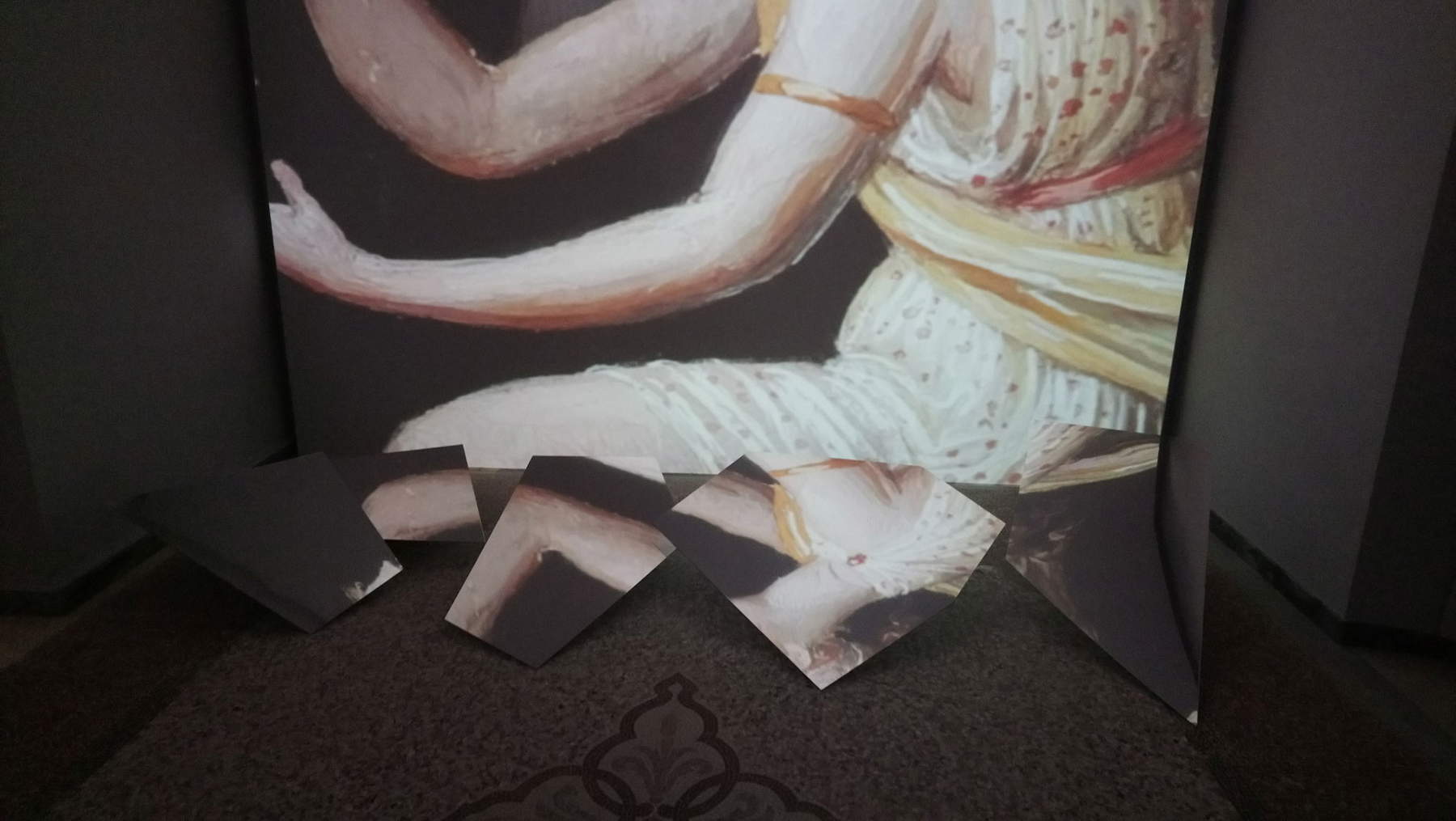 |
| More pointed mirrors on the floor, in the room on Canova and dance |
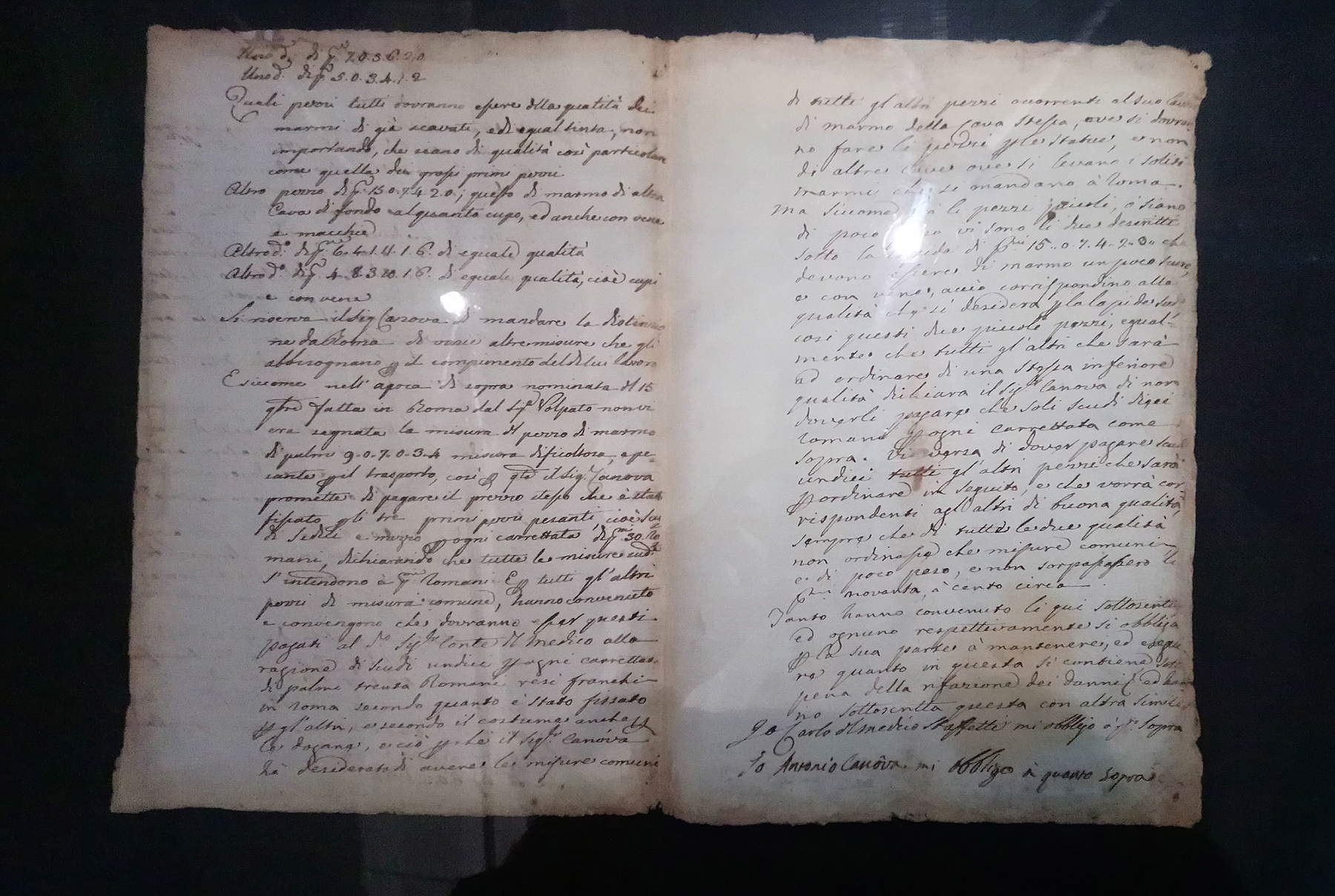 |
| The contract between Count Del Medico and Canova for the supply of marbles, the only new feature of the exhibition |
With this doubt, we proceed along the path, where we come across (came across) the Dancer with her finger on her chin, behind which scrolled reproductions of details taken from Canova’s paintings on the theme of dance: and, here again, rather than occupying an entire wall with useless videos of which the visitor has no control, would it not have been better (if the intent was really to familiarize the public with the details of Canova’s works) to insert photographs so that participants could manage their visit independently? Negative answer, of course, since multimedia would have been lost, and the conceptual scaffolding of the exhibition would have ineluctably collapsed: better, then, to expose oneself to the risk of staging a useless event. The only room that is saved is, paradoxically, the one least appealing to the public, that is, the one that exhibits the archival documents: here there is little to object to and, above all, there is a way, at last, to delve into the relationship between Canova and Carrara with the support of letters and notes and with good illustration. In fact, little or nothing can be said about the texts and explanatory apparatus, prepared by a respectable team that includes curator Mario Guderzo, director of the Gipsoteca Canoviana in Possagno, and art historians such as Marco Ciampolini, director of CARMI, and Giuliano Pisani, all with the scientific contribution of Giuseppe Pavanello, among the leading experts on Antonio Canova.
However, in the face of such a miserable result, and especially of an exhibition that changes in haste, losing all the works of art that, to be frank, were the only reason that could have justified a visit, even the work of the experts who put themselves at the service of this rambling jumble comes out debased and tarnished. This is a pity, because the idea of thematic scansion (the creative process, the focus on Paolina Borghese, the in-depth study on Canova and dance, his relationship with Carrara, the conclusion with the story of Cupid and Psyche), if approached in the manner of a traditional exhibition, could have constituted an interesting moment of disclosure on Canova’s art. But this being the case, with an exhibition left without works, full of useless reproductions and videos, we might as well buy a book. Maybe not the laughable exhibition catalog, though: little more than a pamphlet (sold at a high price: twenty euros), which largely recycles the texts of Magister Canova, reproduces those of the exhibition without offering essays or more far-reaching contributions, and does not even deign to devote not a card, but not even a photograph, to the only new item that has emerged, the document from the Sarteschi collection on the supply of marbles mentioned above (another new item will be presented instead in the coming days, and it will be a major event, although it will not be enough to lift the overall discourse on the exhibition). In the coming months, Carrara will host a major exhibition on Giovanni Antonio Cybei, the first monographic exhibition dedicated to the great 18th-century artist, which will be able to count on a project drawn up by a scientific committee that brings together the sculptor’s leading experts: hopefully it will be an opportunity to show that to organize good exhibitions one does not need high-sounding names or multimedia phantasmagoria, but simply seriousness and originality.

The author of this article: Federico Giannini
Nato a Massa nel 1986, si è laureato nel 2010 in Informatica Umanistica all’Università di Pisa. Nel 2009 ha iniziato a lavorare nel settore della comunicazione su web, con particolare riferimento alla comunicazione per i beni culturali. Nel 2017 ha fondato con Ilaria Baratta la rivista Finestre sull’Arte. Dalla fondazione è direttore responsabile della rivista. Nel 2025 ha scritto il libro Vero, Falso, Fake. Credenze, errori e falsità nel mondo dell'arte (Giunti editore). Collabora e ha collaborato con diverse riviste, tra cui Art e Dossier e Left, e per la televisione è stato autore del documentario Le mani dell’arte (Rai 5) ed è stato tra i presentatori del programma Dorian – L’arte non invecchia (Rai 5). Al suo attivo anche docenze in materia di giornalismo culturale all'Università di Genova e all'Ordine dei Giornalisti, inoltre partecipa regolarmente come relatore e moderatore su temi di arte e cultura a numerosi convegni (tra gli altri: Lu.Bec. Lucca Beni Culturali, Ro.Me Exhibition, Con-Vivere Festival, TTG Travel Experience).
Warning: the translation into English of the original Italian article was created using automatic tools. We undertake to review all articles, but we do not guarantee the total absence of inaccuracies in the translation due to the program. You can find the original by clicking on the ITA button. If you find any mistake,please contact us.